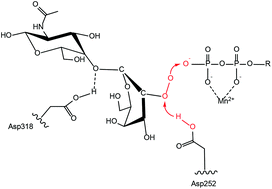How inverting β-1,4-galactosyltransferase-1 can quench a high charge of the by-product UDP3− in catalysis: a QM/MM study of enzymatic reaction with native and UDP-5′ thio galactose substrates†
Abstract
The catalysis of inverting glycosyltransferases consists of several biophysical and biochemical processes during which the transfer of a sugar residue from the purine phosphate donor substrate to an acceptor substrate occurs with stereo-inversion of the anomeric C1 center at a product. During catalysis a highly charged phosphate by-product (UDP3−) is formed and a mechanism of how the enzyme stabilizes it back to the UDP2− form is not known. Using methods of molecular modeling (hybrid DFT-QM/MM calculations) we proposed and validated a catalytic mechanism of bovine inverting β-1,4-galactosyltransferase-1 (β4Gal-T1) with native (UDP-galactose) and thio donor substrates (UDP-5′ thio galactose). We focused on three aspects of the mechanism not yet investigated: (i) the formation of an oxocarbenium ion intermediate, which was only found for the retaining glycosyltransferases for the time being; (ii) the mechanism of stabilization of a highly charged phosphate by-product (UDP3−) back to its standard in vivo form (UDP2−); (iii) explanation for why in experimental measurements the rate of catalysis with the thio donor substrate is only 8% of the rate of that with the natural substrate. To understand the differences in the interaction patterns between the complexes enzyme : UDP-Gal and enzyme : UDP-5S-Gal, fragmented molecular orbital (FMO) decomposition energy analysis was carried out at the DFT level.

- This article is part of the themed collections: Chemical Biology in OBC and Mechanistic, computational & physical organic chemistry in OBC


 Please wait while we load your content...
Please wait while we load your content...